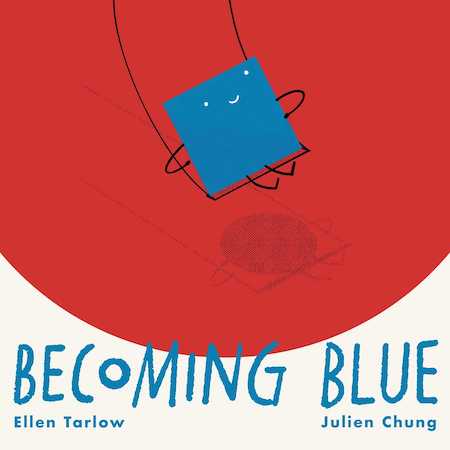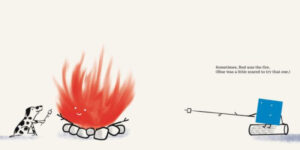
BECOMING BLUE by Ellen Tarlow, illustrated by Julien Chung
978-1665900010 | Beach Lane/S&S
Dangling from a tree, rushing to put out a fire, or popping up in the middle of traffic with her best word: STOP. “Red was always up to something. And it was always fascinating.” Blue didn’t have that kind of power. Or that kind of fun. It seemed as if nobody even noticed Blue.
Ellen Tarlow’s newest book is a thoughtful and clever look at self-discovery, finding our rightful place in the world, and appreciating both our own strengths and the strengths of others. Along the way, we might be surprised to discover new things about ourselves we hadn’t even imagined possible!
I’m excited Ellen agreed to hop on ReaderKidZ this week to answer a few questions.
DW: Welcome back, Ellen! The last time you visited ReaderKidZ, we were celebrating the release of LOOKING for SMILE, illustrated by Lauren Stringer. It’s a gorgeous and gentle story about friendship, and the reality that – sometimes – there are days and times when things aren’t as upbeat and full of smiles as we’d like.
But, TODAY? We’re celebrating the publication of your newest, BECOMING BLUE, a picture book about becoming our true selves and *also* about discovering we are more than we think we are.
You have an amazing ability to tap into emotions children experience (but can’t always put into words) in very concrete, tangible ways. Emotions that are also deeper truths of adulthood. Which begs the question – how did you come up with the idea behind BECOMING BLUE? What inspired the story? What do you hope readers take away? Were there any challenges in writing this book?
ET: First of all, thank you so much for featuring Becoming Blue, Dianne! I can’t think of a better place to celebrate BECOMING BLUE’S publication day.
BECOMING BLUE began because my agent (Rubin Pfeffer) suggested I try a book about color. He knew that my husband, a painter and art professor, had written a book on color for artists and designers and thought it might be a good fit for me.
It had never occurred to me to write a color book before, but I immediately responded that Leo Lionni’s classic, LITTLE BLUE, LITTLE YELLOW, had long been one of my favorites.
So I went away thinking about colors. I tend to write emotional stories with characters for very young children. So I knew that my book would be more like that than a concept book celebrating colors.
For a couple of months, I fiddled with different color characters and storylines but nothing seemed quite right. Then one day I was reading (the wonderful book) ON EARTH WE ARE BRIEFLY GORGEOUS by Ocean Vuong, which tells the story of a young Vietnamese immigrant to the U.S. There is a sequence in which, at six years old, he starts to copy an American boy he admires. It ends with the American boy yelling (from the top of a slide) “Stop following me!” It is a horrifying moment of shame and one that I could connect to (though never called out like that, I did my share of copying those kids who seemed to “just know”). It also seemed like an important topic for kids today who have so many impossible idealizations coming at them from all angles and could really use the encouragement to just be themselves.
That story of the two boys on the slide, sparked the idea of having one of the colors (Blue) want to BE another color (Red). I also knew that I wanted to the story to center on a shaming scene in which Blue is told by Red to “Stop Copying Me!” Which would give Blue he change to go off to find himself.
At that point, the book pretty much wrote itself. Having the story be about colors allowed for a light touch on a rather intense topic and the depiction of some amazing visual transformations.
Writing wise, I knew I was on the right track when Blue’s tears (after being told by Red to “Go Be Blue!”) turn him into a river, which is how he discovers that he can be water and is the equal to Red. It was one of those flowy writing moments that happen all too rarely.
DW: As you were writing about a somewhat abstract concept (Blue and Red – the colors – are characters with human emotions and feelings), did you have any thoughts about how the book might be illustrated? Did you include illustration notes? Did you have any input in choosing the illustrator? Can you share a favorite spread?
ET: I LOVE the way the illustrations came out. Julien Chung went above and beyond (and yes, I did have input on selecting him as the illustraton). When I was writing it, I was certainly a little worried about how this story would actually work on the page.
Julien did an amazing job of navigating the challenges. In my head the characters were more fluid and lived in a naturalistic looking environment. Julien’s stylization and limited color palette makes it so much more focused. Also, his modernist, graphic sensibility really elevated the look of the book. And the emotion and charm he squeezed out of a blue square and red circle surprised and delighted me.
He also added many fun touches. One is a dog who appears in most of the episodes as a funny, happy-go-lucky counterpoint to Blue’s anxiety. (Kind of like Snoopy and Charlie Brown.)
I love so many spreads. But I will share this one. It shows Red turning into fire and Blue realizing he is a little scared to even try to copy that one.
CLICK TO ENLARGE © illustration by Julien Chung
When I wrote it, I was worried about how an illustrator could make a fire character sweet and suitable for four-year olds. But as you can see, Julien did it. You can also see how the dog adds so much charm. And I love the funny touches such as Blue’s tiny marshmallow stick that purposely will never come near the fire.
DW: I know you’ve got more books on the way. What have you been working on recently? What can readers look forward to next?
ET: BECOMING BLUE seems to have unlocked an affinity for inanimate objects as characters. At the moment, I have another color manuscript, a manuscript about a pair of common tools and one about shapes. (My agent might be regretting suggesting colors to me!)
In terms of books that are actually coming out, Beach Lane has three more picture books and one early reader series. The next picture book up (I think) is about a tree, mortality, reforestation, and some funny animals. (I have to work on my elevator speech for that!) It is being illustrated by Daniel Miyares which I am very excited about!
DW: Thanks, Ellen! I’m excited for readers, teachers, and parents to discover BECOMING BLUE and we’ll be sure to keep an eye out for your next books. 🙂
***
- Learn more about Ellen on her website.
- You might also enjoy this Guide to Using Books about Feelings and Emotions











